
New tool to control information relay in cells
EMBL scientists and collaborators have created molecular messengers that can be switched on or off at will, to study the communication networks that drive cells’ responses to outside stimuli

When your blood sugar (glucose) rises, cells in the pancreas respond by secreting insulin. This seemingly simple reaction actually requires information to be passed from one molecule to another, like a baton in a relay race. The cell first detects the change in its surroundings through receptors on its membrane. These receptors relay that information to a group of second messengers called diacylglycerides (DAG), which trigger the chain reactions inside the cell that ultimately result in it producing insulin. Thanks to a new approach led by Carsten Schultz at EMBL and Dirk Trauner at Ludwig-Maximilians University in Munich, Germany, researchers can now rapidly turn those second messengers on and off at will, inside living cells, to better study this information relay.
“We have created versions of three DAGs that we can switch on simply by exposing them to a flash of UV light, and then we can switch them off again by exposing them to blue light,” says Schultz. “These DAGs are involved not only in insulin secretion, but also in neurotransmission, so by looking at what happens when we turn these DAGs on or off people can begin to really understand how those processes are triggered and regulated within cells.”


